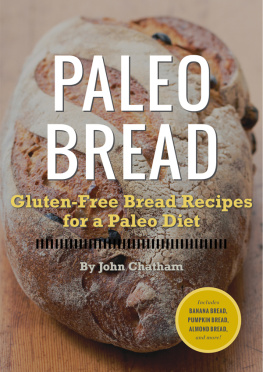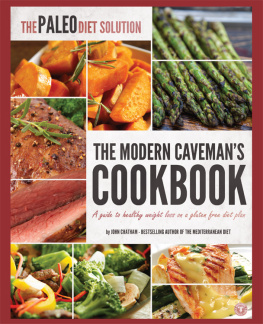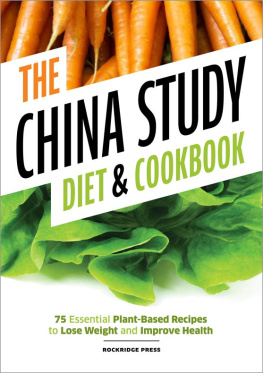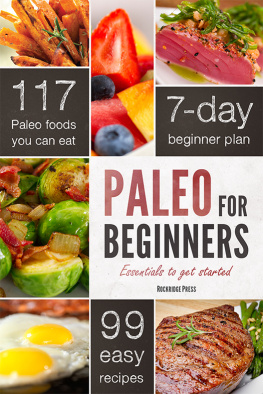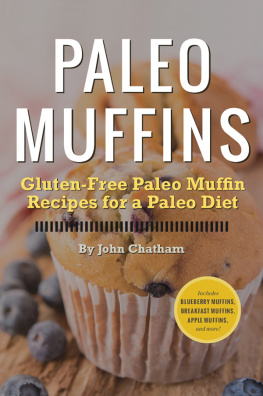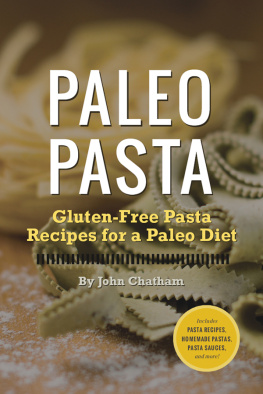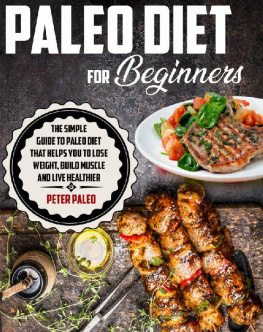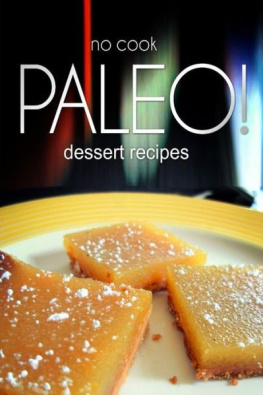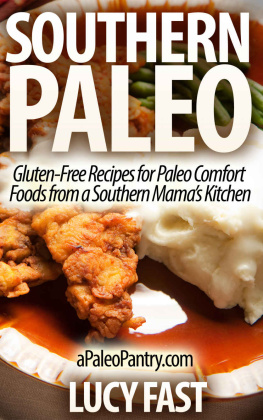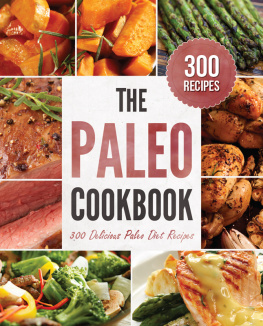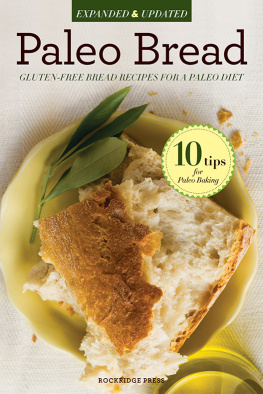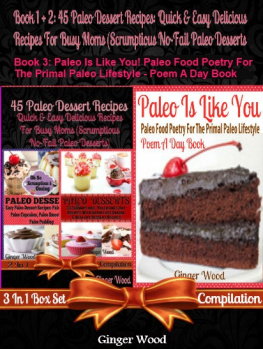INTRODUCTION
I f youre one of the millions of people who suffer from such conditions as celiac disease, type 2 diabetes, heart disease, obesity, or digestive disorders, then you may be looking for a diet that can help you take control of your condition. Because all of these illnesses are affected by poor dietary choices, you may be considering the Paleo diet but have some reservations because of the restrictions. If so, read on!
Regardless of what literature youve read on the subject, most medical professionals agree that ingredients such as processed flours, white sugar, artificial preservatives, and empty calories are bad for you. Once you cut these unhealthful ingredients out of your diet, youre going to feel better, look better, and be healthier in general. The problem is that it sounds a whole lot easier than it actually is, at least in the beginning.
The Western diet is based almost entirely upon ingredients that make you sick. If youre like the typical American, you have a bagel made from processed flour and loaded with fattening cream cheese for breakfast, then you have a fast-food cheeseburger and fries for lunch, and perhaps spaghetti and meatballs with garlic bread for dinner. Oh, and dont forget the chips or cookies that you grab for a quick snack between meals and the ice cream that you have for dessert.
With all of that delicious convenience, its no wonder that, as a country, were literally eating ourselves to death!
For years, faithful followers of the Paleo diet and other diets that restrict all of those empty carbs and processed grains have sacrificed such foods as breads in order to reap the benefits of healthful eating. If youre one of those people who, by medical necessity or sheer willpower, have grudgingly chosen to give up bread solely because processed flour is horrible for you, then weve got great news: Bread is back, and its delicious!

WHAT IS THE PALEO DIET?
W hether modern health care professionals want to admit it or not, the Paleo diet closely mirrors what most of them tell their patients: eat more fruits, vegetables, and lean meats, and stay away from processed garbage. The diet, also known as the Stone Age diet, the caveman diet, and the hunter-gatherer diet, has gained a significant following in recent years, and theres some pretty good research to support the switch.
How Did the Paleo Diet Start?
Back in the 1970s a gastroenterologist by the name of Walter L. Voegtlin observed that digestive diseases such as colitis, Crohns disease, and irritable bowel syndrome were much more prevalent in people who followed a modern Western diet than it was in our ancestors, whose diet consisted largely of vegetables, fruits, nuts, and lean meats. He began treating patients with these disorders by recommending diets low in carbohydrates and high in animal fats.
Unfortunately, the medical world simply wasnt ready to give up the idea that a low-fat, low-calorie diet was the healthiest way to eat, so Dr. Voegtlins observations and research went largely unnoticed, and the Paleo diet was shoved to the back of the drawer.
FinallyThe Stone Age Is Cool Again!
Fast forward a decade to a point when medical researchers had gained considerably more insight into how the human body actually works. Melvin Konner, S. Boyd Eaton, and Marjorie Shostak of Emory University published a book called The Paleolithic Prescription: A Program of Diet and Exercise and a Design for Living, then followed it up with a second book, The Stone-Age Health Programme: Diet and Exercise as Nature Intended. The first book became the foundation for most of the modern versions of the Paleo diet and the second backed it up with more research.
The main difference was that instead of eliminating any foods that our ancestors wouldnt have had access to as Dr. Voegtlin did originally, Konner, Eaton, and Shostak encouraged eating foods that were nutritionally and proportionally similar to a traditional caveman diet. Because it was more realistic, the diet caught on like wildfire, and the research in favor of it continues to grow.
What Are the Rules?
Paleo is one of the easiest diets on the planet to follow: just remember to keep it real. If its processed, artificial, or otherwise not directly from the earth, dont eat it. Its that simple. Dairy is one of the foods that people debate allowing, and well discuss it later, but for now, its forbidden. Heres a list of the delicious, healthful foods that the Paleo diet encourages:
- Eggs
- Healthful oilsolive and coconut are best; canola oil is under debate right now, too
- Lean animal proteins
- Nuts and seeds (note, however, that peanuts are not nuts)
- Organic fruits
- Organic vegetables
- Seafood, especially cold-water fish such as salmon and tuna in order to get the most omega-3 fatty acids
Sounds kind of familiar, doesnt it? Thats because its probably what your doctor encouraged you to eat more of the last time you went to see him or her! Now lets take a look at some foods that are off the table if youre going to eat Stone Age style:
- Alcohol
- Artificial foods, such as preservatives and zero-calorie sweeteners
- Cereal grains, such as wheat, barley, hops, corn, oats, rye, and rice
- Dairy (though some followers allow dairy for the health benefits)
- Legumes (including peanuts)
- Processed foods, such as wheat flour and sugar
- Processed meats, such as bacon, deli meats, sausage, and canned meats
- Starchy vegetables (though these are currently under debate)
Frequently Asked Questions
Now that you have a general idea of what you can and cant eat, you may still have a few questions, so weve put together a list of those most frequently asked.
Q. Why do you have to quit drinking?
A. Beer is basically liquid grain, and its packed with empty calories. Many types of alcoholic products contain gluten, which well discuss in later chapters. Mixed drinks and wine are often loaded with sugar. If you absolutely cant go without that Friday-night cocktail, shoot for red wine, tequila, potato vodka, or white rumand be careful what you mix it with.
Q. Why are legumes forbidden? Theyre natural foods and great sources of protein.
A. Most legumes, in their raw state, are toxic. They contain lectins proteins that bind carbohydrates and have been shown to cause such autoimmune diseases as lupus and rheumatoid arthritis. The phytates in many legumes inhibit your absorption of critical minerals, and the protease inhibitors interfere with how your body breaks down protein.
Q. Why no dairy?
A. This ones under debate and there are many Paleo followers who still incorporate dairy regularly into their diets. The main reason that dairy is generally forbidden is that humans are the only animals who drink milk as adults, and many food allergies and digestive disorders are lactose-related. Theres a much more scientific answer for this question, but it boils down to believing or not believing that milk is bad for you.
Q. How will I lose weight eating fat?
A. This is a question that most people have initially because were all programmed to believe that red meat is bad for your heart. The fact is, lean, organic, free-range meat is an excellent source of protein and many other vitamins and minerals. Youre not going to be living on it alone: youre going to be incorporating it into a healthful diet.
Q. Peanuts are nuts and corn is a vegetable, so why are they off-limits?
A. Au contraire. Peanuts are legumes and corn is a grain. Be careful that you know what food groups everything you eat falls into or you may sabotage your efforts to be healthier.
Next page
